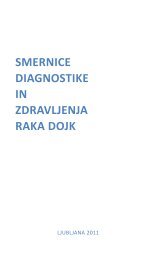Create successful ePaper yourself
Turn your PDF publications into a flip-book with our unique Google optimized e-Paper software.
Response to VEGF receptor inhibition and vascular disrupting therapy<br />
<strong>of</strong> mouse tumours expressing only single is<strong>of</strong>orms <strong>of</strong> VEGF-A<br />
Simon Akerman, Neil A. Cross, Katie L. Pettyjohn, Leigh J. Williams, Matthew Fisher,<br />
Helen Evans, Meit A. Bjorndahl, Sheila Harris, Paul R. Barber, Chryso Kanthou, Vivien<br />
E. Prise, Sally A. Hill, Gillian M. Tozer<br />
Cancer Research UK Tumour Microcirculation Group, Academic Unit <strong>of</strong> Surgical Oncology, University<br />
<strong>of</strong> Sheffield, Royal Hallamshire Hospital, Sheffield, S10 2JF<br />
Mouse fibrosarcomas expressing only single VEGF-A is<strong>of</strong>orms (120, 164 or 188), or all<br />
is<strong>of</strong>orms (w/t) under endogenous promoter control have been developed. Subcutaneous<br />
VEGF120 tumours transplanted into SCID mice have poor vessel wall development, with<br />
very few α-smooth muscle actin or desmin staining cells, indicative <strong>of</strong> lack <strong>of</strong> pericytes.<br />
This is associated with susceptibility to vessel breakdown following treatment with the<br />
prototype tumour vascular disrupting agent, combretastatin A4-phosphate (CA-4-P).<br />
VEGF188 tumours have more uniform vascular networks and better-developed vessel<br />
walls (positive staining for α-smooth muscle actin and desmin) than VEGF120 tumours<br />
and are less responsive to CA-4-P. We tested the effect <strong>of</strong> chronic treatment with a VEGF<br />
receptor inhibitor, SU5416, on angiogenesis in the different tumour types and subsequent<br />
response to CA-4-P.<br />
Measurements <strong>of</strong> angiogenesis and vascular response to CA-4-P in VEGF120, 164, 188<br />
and w/t tumours were studied in SCID mice using dorsal skin flap window chambers.<br />
Subcutaneously implanted tumours were studied for growth measurements and to<br />
perform immunohistochemistry. In subcutaneous tumours, SU5416 (50 mgkg-1, i.p,<br />
twice weekly) did not affect growth rates in any tumour line. There were higher levels<br />
<strong>of</strong> α-smooth muscle actin staining in SU5416-treated VEGF120 tumours than untreated<br />
tumours, implying greater vascular maturity, in terms <strong>of</strong> pericyte recruitment. Less effect<br />
<strong>of</strong> SU5416 on pericyte staining was observed in the other tumour types. In the window<br />
chamber, angiogenesis was inhibited in all VEGF-is<strong>of</strong>orm tumours treated with SU5416,<br />
as measured<br />
l53<br />
by total vessel length density versus time after transplantation. In VEGF120<br />
tumours pre-treated with SU5416 (50 mgkg-1, i.p, twice weekly), CA-4-P (30 mgkg-1,<br />
i.v) decreased red blood cell velocity after 1hr, but there was complete recovery by 24hrs.<br />
In contrast, in VEGF120 tumours either pre-treated with vehicle (twice weekly), or<br />
untreated tumours, CA-4-P caused rapid vascular shutdown and haemorrhage with no<br />
recovery after 24hrs. SU5416 had less effect on response to CA-4-P treatment in the other<br />
tumour types, in keeping with the results for pericyte staining.<br />
The VEGF receptor inhibitor SU5416 caused a significant ‘normalization’ <strong>of</strong> the<br />
vasculature in VEGF120 tumours, involving an increased proportion <strong>of</strong> tumour vessels<br />
that are stabilised by pericytes, and resulting in a poor response to CA-4-P. These results<br />
suggest that response to vascular disrupting agents is strongly influenced by pericyte<br />
investment and that vascular normalisation may be an undesirable effect <strong>of</strong> anti-angiogenic<br />
agents such as SU5416.<br />
71<br />
This work was funded by Cancer Research UK
















